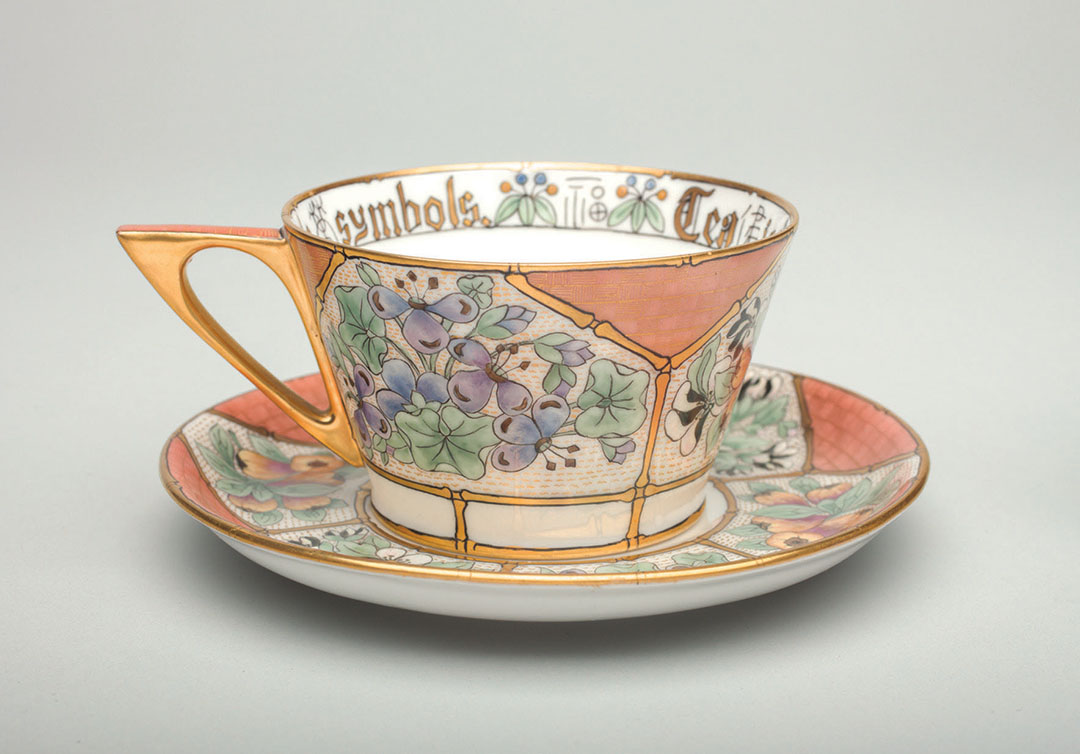Item Composition
China
Item Medium
Porcelain
Item Origin
Chicago, Illinois
Item Duration at Mansion
Temporary
Summary
Cup: 31⁄8 inches in diameter, Saucer: 5¼ inches in diameter Inscription: Smiles crown the welcome and make every dish a feast. Florence Donovan Pratt Steward (1851, Auburn, New York–1921, Chicago, Illinois), decorator. Collection of Chicago History Museum
Item Composition
China
Item Medium
Porcelain
Item Origin
Chicago, Illinois
Item Duration at Mansion
Temporary
In February 1893, Florence Pratt Steward organized 15 of Chicago's most talented female china decorators to create an exhibition of their work in the Woman's Building at the World's Columbian Exposition in Chicago. Calling themselves the Atlan Ceramic Art Club, they made a creditable showing, winning 18 medals, more than any other club in the country.
The Atlan's goal was to develop a style of ceramic decoration that would be "original" and "distinctly American." Toward this end, members adopted "conventional" decoration—the stylization and original configuration of plants and other motifs drawn from nature—as the only acceptable style for their work. It soon became the club's trademark.
In 1898, seeking professional guidance in design, they engaged Florence Koehler, a talented artist and china painter, who showed them how to use enamel paints on porcelain and introduced the club to her philosophy of Historic Ornament, which advocated deriving conventionalized designs from different cultural traditions—Egyptian, Persian, Arabic, Moorish, East Indian, Chinese, and Japanese. The chocolate pot decorated with stylized Japanese chrysanthemums by Eva E. Adams is an example of the Club's 1898 course work in Historic Ornament.
The concept of Historic Ornament intrigued Atlan members, who worked to perfect their technique in the various styles for several years. In 1910, Florence Steward exhibited a "conversational set"— a dessert service with each of its seven place settings inspired by one of the seven cultural traditions.
Helen Frazee, who maintained a studio in the Auditorium building, was proficient in figural work, landscapes, and floral studies as well as colorful and imaginative stylized designs. She is credited with the first application of conventionalized designs in low relief enamel on pale yellow Satsuma pottery, which became a hallmark of the club.
Atlan membership was restricted to 25 Chicagoans and a few outsiders, although associate members, who could participate in the annual club training courses, often numbered more than 60. Various members served as president until 1910, when founder Florence Steward was elected director general for life. Most of the active members were professional china decorators, many of whom were graduates of the School of the Art Institute of Chicago. Several maintained studios where they taught china painting and sold their work; others worked out of their homes. Beginning in 1894, the Atlan Ceramic Art Club held much-anticipated exhibitions of their work at the Art Institute of Chicago. Annual exhibitions continued for 31 years, until the Club merged with the Technic Art League (formerly the Chicago Ceramic Art Association) in 1923. Its memory lives on in the Atlan Ceramic Club Fund, established by members to purchase ceramics for the Art Institute of Chicago's permanent collection.
Item Composition
China
Item Medium
Porcelain
Item Origin
Chicago, Illinois
Item Duration at Mansion
Temporary


